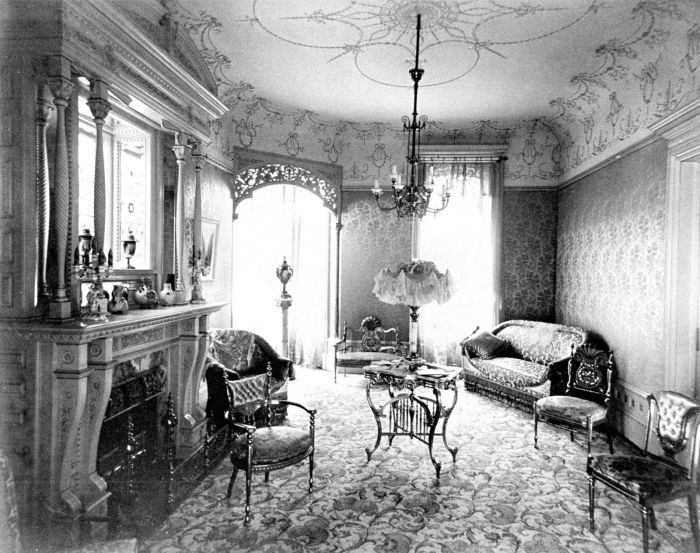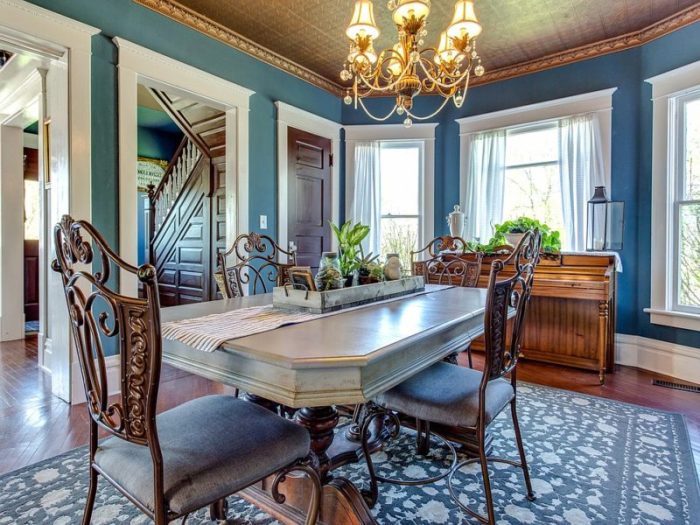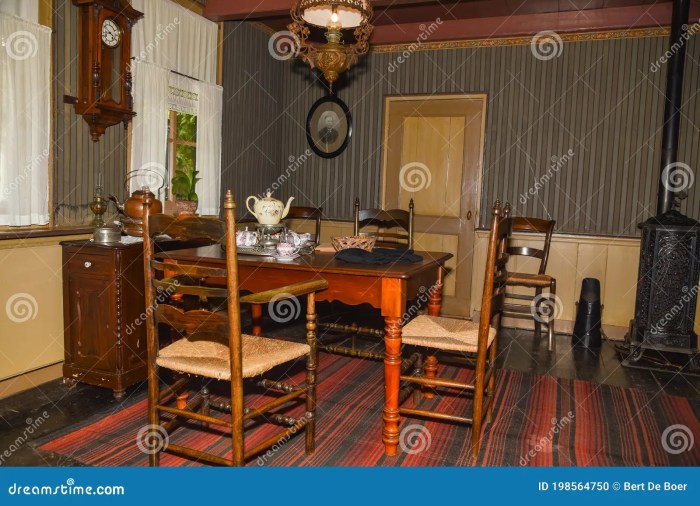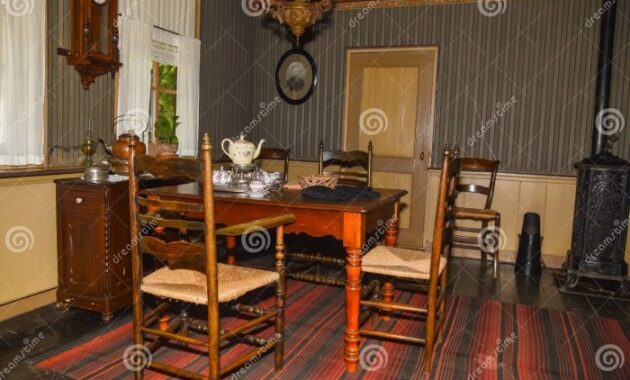1900 house interior design transports us back to an era of elegance and craftsmanship. This period, encompassing the Victorian, Edwardian, and Arts and Crafts movements, witnessed a flourishing of decorative arts that shaped the homes of the time. From ornate details to the use of natural materials, 1900s interiors were a reflection of the social and cultural values of the era.
The defining characteristics of 1900s home interiors included a focus on craftsmanship, the use of natural materials, and a sense of formality. Furniture was often handcrafted from wood, and decorative elements like wallpaper, textiles, and lighting played a crucial role in creating a specific ambiance.
Color palettes were rich and evocative, with hues like deep reds, greens, and blues often used to create a sense of warmth and sophistication.
Key Features of 1900s Interior Design

The turn of the 20th century witnessed a dramatic shift in interior design, moving away from the opulent Victorian era and embracing a new aesthetic that was both elegant and functional. This period, often referred to as the Edwardian era, saw the rise of Arts and Crafts, Art Nouveau, and early Modernist influences, resulting in homes that were characterized by their craftsmanship, natural materials, and attention to detail.
The Use of Natural Materials
Natural materials played a significant role in creating the warm and inviting ambiance of 1900s interiors. Oak, mahogany, and walnut were popular choices for furniture, flooring, and paneling, while fabrics like linen, cotton, and wool were used for upholstery and curtains.
The use of these materials not only contributed to the overall aesthetic but also emphasized a connection to nature and a rejection of mass-produced goods.
Ornate Details and Craftsmanship
s interiors were known for their intricate details and high-quality craftsmanship. This was evident in the furniture, which often featured hand-carved elements, intricate inlays, and ornate hardware. Similarly, the walls were adorned with decorative moldings, wainscoting, and fireplaces that were often elaborately decorated with tiles or marble.
This attention to detail reflected the pride in skilled craftsmanship and the desire to create spaces that were both beautiful and enduring.
The Role of Wallpaper and Textiles, 1900 house interior design
Wallpaper played a crucial role in setting the tone of 1900s interiors. Floral patterns, geometric designs, and scenic murals were popular choices, often used to create a sense of depth and visual interest. Textiles were equally important, with rich fabrics like velvet, silk, and brocade used for draperies, upholstery, and throws.
These fabrics added a touch of luxury and sophistication to the overall design, while also providing warmth and comfort.
While 1900 house interior design often featured ornate details and a focus on craftsmanship, modern homeowners might find inspiration in the efficient layout and functionality of a 1500 square feet house interior design. This approach can help create a comfortable and stylish space within a smaller footprint, drawing inspiration from the elegance of the past while embracing contemporary needs.
Lighting
Lighting in 1900s homes was both functional and decorative. Chandeliers, sconces, and lamps made of brass, bronze, or wrought iron were commonly used to illuminate the space. These lighting fixtures were often adorned with crystal or glass accents, adding a touch of sparkle and elegance to the room.
1900 house interior design often features intricate details, like ornate moldings and stained glass windows. While these elements can add charm, they might feel overwhelming in a smaller space. If you’re working with a limited footprint, consider a more streamlined approach, like the ideas presented in 120 sq yards house interior design.
Even with less square footage, you can still achieve a timeless elegance by incorporating classic 1900s design elements in a simplified way.
In addition to the main lighting sources, smaller lamps and candles were used to create a more intimate and cozy atmosphere.
Furniture
Furniture in 1900s interiors was characterized by its elegant lines, comfortable proportions, and high-quality craftsmanship. Some common pieces include:
- Chesterfield Sofa:Known for its deep buttoned back and rolled arms, the Chesterfield sofa was a popular choice for both formal and informal spaces.
- Wingback Chair:With its tall, wing-shaped back and padded arms, the wingback chair provided both comfort and a sense of privacy.
- Sideboard:A versatile piece of furniture that could be used to store china, linens, or other household items, the sideboard often featured intricate carvings and decorative hardware.
- Writing Desk:Designed for both work and leisure, writing desks were often made of mahogany or oak and featured elaborate inlays and decorative hardware.
- Grandfather Clock:A timeless and elegant piece, the grandfather clock was a symbol of both status and good taste.
Color Palette
The color palette of 1900s interiors was typically muted and sophisticated, with a preference for warm neutrals like cream, beige, and brown. These colors were often accented with pops of color from floral patterns in wallpaper and textiles, or from the rich wood tones of furniture.
Conclusion
The interior design of the 1900s reflected a shift in aesthetic sensibilities, embracing a blend of elegance, functionality, and craftsmanship. The use of natural materials, intricate details, and a sophisticated color palette created spaces that were both beautiful and inviting.
Room Design Principles
The Victorian era, spanning the late 19th century, witnessed a flourishing of architectural and interior design styles. This era was marked by a penchant for ornate embellishments, intricate detailing, and a harmonious blend of comfort and grandeur. The design principles applied to rooms during this time reflect a meticulous approach to creating spaces that were both aesthetically pleasing and functional.
Room Layouts and Design Principles
The following table illustrates typical room layouts and design principles for living rooms, bedrooms, and dining rooms in 1900s homes:
| Room | Layout | Design Principles |
|---|---|---|
| Living Room |
|
|
| Bedroom |
|
|
| Dining Room |
|
|
Symmetry, Balance, and Focal Points
The concept of symmetry and balance played a crucial role in 1900s interior design. Symmetry, the mirroring of elements on either side of a central axis, created a sense of order and harmony. This principle was often employed in the arrangement of furniture, with pieces being placed in symmetrical groupings around a focal point.
1900 house interior design often embraced ornate details and grand spaces, a stark contrast to the modern minimalist aesthetic. However, even with limited square footage, clever design principles can create a sense of spaciousness and grandeur. For those looking to maximize small spaces, exploring 100 sq ft house interior design can offer valuable insights.
The challenges of small space design can be applied to any era’s style, allowing you to recreate the elegance of 1900s design even in a compact setting.
“Symmetry and balance are essential for creating harmonious spaces. They create a sense of order and visual appeal.”
Focal points, such as fireplaces, large windows, or elaborate artwork, were strategically placed to draw the eye and create a sense of interest. These focal points often served as the starting point for the overall design scheme, with the surrounding furniture and decor being arranged to complement and enhance their impact.
Natural Light and Ventilation
Natural light and ventilation were highly valued in 1900s home design. Large windows, often with elaborate bay windows, were incorporated to maximize the amount of natural light that entered the home. This not only illuminated the rooms but also created a sense of spaciousness and airiness.
“Natural light and ventilation were crucial for creating healthy and comfortable living spaces.”
In addition to windows, other features such as skylights and transoms were also used to bring in natural light. These features were not only aesthetically pleasing but also played a practical role in regulating the temperature and humidity of the home.
Proper ventilation was essential for ensuring good air quality and preventing the buildup of moisture and odors.
Evolution of 1900s Interior Design: 1900 House Interior Design

The early 20th century witnessed a dramatic shift in interior design aesthetics, moving away from the ornate Victorian era towards a more streamlined and functional approach. This evolution was driven by a confluence of factors, including the rise of new technologies, social changes, and emerging artistic movements.
Impact of Art Deco and Modernism
Art Deco, with its geometric patterns, luxurious materials, and emphasis on craftsmanship, emerged in the 1920s and quickly gained popularity. This style brought a sense of glamour and sophistication to home interiors, influencing everything from furniture design to wallpaper patterns.
Art Deco interiors often featured bold colors, geometric shapes, and luxurious materials like chrome, lacquer, and exotic woods. Modernism, with its emphasis on simplicity, functionality, and clean lines, gained traction in the 1930s and 1940s. This movement rejected the extravagance of Art Deco and sought to create spaces that were both beautiful and practical.
Modernist interiors typically featured simple furniture with clean lines, neutral colors, and natural materials like wood and leather.
Key Differences between Early and Later 1900s Design Styles
Early 1900s interior design styles, such as Arts and Crafts and the Edwardian era, were characterized by a more traditional approach, often featuring intricate details, handcrafted furniture, and a focus on natural materials. Later 1900s design styles, influenced by Art Deco and Modernism, embraced a more minimalist and functional aesthetic, emphasizing clean lines, geometric shapes, and the use of new materials like chrome and plastic.
- Early 1900s:
- Intricate details and ornamentation
- Handcrafted furniture and textiles
- Emphasis on natural materials like wood, leather, and wool
- Warm, inviting color palettes
- Later 1900s:
- Clean lines and geometric shapes
- Mass-produced furniture and textiles
- Use of new materials like chrome, plastic, and glass
- Bold colors and patterns, often inspired by Art Deco
Closing Notes

Exploring 1900 house interior design offers a captivating journey through time, revealing the enduring allure of this era’s aesthetic. Whether you’re drawn to the ornate details of Victorian interiors, the simplicity of Arts and Crafts designs, or the elegance of Edwardian homes, there’s something to appreciate in the craftsmanship, artistry, and sense of history that these interiors embody.
Commonly Asked Questions
What are some common furniture pieces found in 1900s homes?
Common furniture pieces in 1900s homes included ornate sofas, wingback chairs, grandfather clocks, sideboards, and dressing tables. These pieces often featured intricate carvings, upholstery in rich fabrics, and a sense of grandeur.
How did lighting affect the ambiance of 1900s interiors?
Lighting played a significant role in creating the ambiance of 1900s interiors. Chandeliers, sconces, and lamps provided a warm glow, while stained glass windows added a touch of color and drama. The use of natural light was also important, with large windows and skylights bringing in ample daylight.
Are there any modern interpretations of 1900s design?
Yes, many contemporary designers draw inspiration from 1900s aesthetics. They often reinterpret traditional elements like ornate details, natural materials, and rich color palettes in a modern context, creating spaces that are both stylish and timeless.

